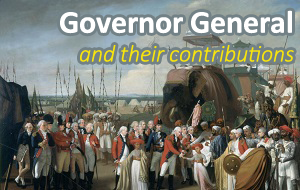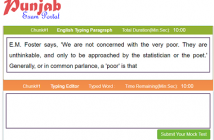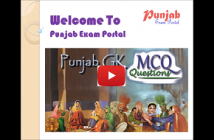| Governor General / Viceroy |
Important Point To Remember for Exam |
Warren Hastings
(1774 – 1785) |
- First Governor General of Bangal,
- During his tenure Regulating Act, 1773 was introduced which brought the dual government of Bengal to an end.
- He was impeached due to mismanagement and personal corruption but was finally acquitted.
|
Lord Cornwallis
(1786 – 1793) |
- Introduced Permanent Settlement of Bengal (or Zamindary System).
- Introduced police reforms.
- He led British forces in the Third Anglo-Mysore War to defeat the Mysore ruler Tipu Sultan.
|
Lord Wellesley
(1798 – 1805) |
- He introduced the policy of Subsidiary Alliance to keep the Indian rulers under control by
keeping British forces in their territory.
- Hyderabad was the first state to accept Subsidiary Alliance.
|
Lord Minto I
(1807 – 1813) |
- Concluded the treaty of Amritsar with Maharaja Ranjit Singh.
|
Lord William Bentinck
(1828 – 1835) |
- He was made the first Governor General of India (earlier the designation was Governor General of Bengal).
- He carried out social reforms such as Prohibition of Sati, Indian people were again appointed as subordinate judges, made English the language of higher education, suppress the thugs.
|
Sir Charles Metcaffe
(1835 – 1836) |
- He abolished all restrictions on vernacular press (He was also called Liberator of the press).
|
Lord Auckland
(1836 – 1842) |
|
Lord Dalhousie
(1848 – 1856) |
- He opened the first Indian Railway from Bombay to Thane in 1853.
- He introduced Telegraph lined from Calcutta to Agra in 1853.
- He introduced the infamous ‘Doctrine of Lapse’ and
captured Satara (1848), Jaipur and Sambhalpur (1849), Udaipur (1852), Jhansi (1853) and Nagpur (1854).
- He made Shimla the summer capital.
- Started the Public Works Department
- Remarriage of widows was legalised by Widow Remarriage Act, 1856.
|
Lord Canning
(1856 – 1862) |
- He was the Governor General during the mutiny of 1857
(India’s First War of Independence). After war he was made first Viceroy of India.
- He withdrew Doctrine of Lapse.
- In 1861, Indian Councils Act was passed.
- Universities at Calcutta, Bombay and Madras was established in 1857.
|
Lord Lawrence
(1864 – 1869) |
- After second Sikh war, he became member of the Punjab Board of Administration and was responsible for numerous reforms which earned him the sobriquet “the Saviour of the Punjab”.
- High Court were constituted at Calcutta, Bombay and Madras in 1865.
|
Lord Mayo
(1869 – 1872) |
- Census was held in 1871.
- He was the only Viceroy of India who was killed in office by a
convict in the Andaman Island in 1872.
|
Lord Lytton
(1876 – 1880) |
- In 1877, he organised the Delhi Durbar in which Queen Victoria was proclaimed with the title
of ‘Kaiser-i-Hind’.
|
Lord Rippon
(1880 – 1884) |
- He repealed the Vernacular Press Act in 1882.
- Age for entry in Civil Services was again raised to 21 years.
- The first Factory Act, 1881, was passed to prohibit child labour.
- He passed Local Self Government Act in 1882.
- He introduced IIbert Bill in 1883.
- He was also known as Father of Local Self Government in India.
|
Lord Dufferin
(1884 – 1894) |
- Indian National Congress was formed.
|
Lord Lansdowne
(1888 – 1894) |
- Indian Council Act was passed in 1892.
- Durand Commission was appointed to demarcate the line between British India and Afghanistan.
|
Lord Curzon
(1899 – 1905) |
- Partition of Bengal in 1905.
- Swadeshi movement launched.
|
Lord Minto
(1905 – 1910) |
- Indian Council Act, 1909 or the Morley-Minto Reforms was passed.
|
Lord Hardinge
(1910 – 1916) |
- King George V of England attended Delhi Durbar in 1911.
- Capital of India shifted from Calcutta to Delhi in 1911.
- Home Rule Movement was launched by Annie Besant.
- Mahatma Gandhi came back to India from South Africa in 1915.
|
Lord Chelmsford
(1916 – 1921) |
- The Government of India Act, 1919 (Montague – Chelmsford reforms) was passed.
- Rowlatt Act, 1919 was passed
- Jallianwala Bagh Tragedy.
- Khilafat Movement.
- Non-Cooperation movement.
|
Lord Reading
(1921 – 1926) |
- Rowlatt Act was repealed.
- Swaraj Party was formed.
- Chauri Chaura incident.
|
Lord Irwin
(1926 – 1931) |
- Simon Commission visited India in 1928.
- Dandi March was launched.
- Civil Disobedience Movement was launched in 1930.
- Gandhi – Irwin Pact was signed.
- First Round Table Conference.
|
Lord Willingdon
(1931 – 1936) |
- Second and Third Round Table Conference in 1931.
- Communal award started by British PM Ramsay Macdonald.
- Poona Pact was signed.
|
Lord Linlithgow
(1936 – 1944) |
- Government of India Act, 1935 enforced in the provinces.
- Cripps Mission visited India in 1942.
- Quit India movement.
|
Lord Wavell
(1944 – 1947) |
- Cabinet Mission Plan.
- Shimla conference between Indian National Congress and Muslim League.
|
Lord Mountbatten
(Mar 1947 – Aug 1947) |
- Last Viceroy of British India and first Governor General of free India.
- Partition of India.
- Succeeded by C. Rajagopalachari, the first and the last Indian Governor General of free India.
|





3 Comments
sir
warren hasting was first governor general of bengal…not india.
sir kindly yeh wale notes ki pdf bhi daal do plz.